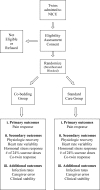Co-bedding as a Comfort measure For Twins undergoing painful procedures (CComForT Trial)
- PMID: 20003351
- PMCID: PMC2804568
- DOI: 10.1186/1471-2431-9-76
Co-bedding as a Comfort measure For Twins undergoing painful procedures (CComForT Trial)
Abstract
Background: Co-bedding, a developmental care strategy, is the practice of caring for diaper clad twins in one incubator (versus separating and caring for each infant in separate incubators), thus creating the opportunity for skin-to-skin contact and touch between the twins. In studies of mothers and their infants, maternal skin-to-skin contact has been shown to decrease procedural pain response according to both behavioral and physiological indicators in very preterm neonates. It is uncertain if this comfort is derived solely from maternal presence or from stabilization of regulatory processes from direct skin contact. The intent of this study is to compare the comfort effect of co-bedding (between twin infants who are co-bedding and those who are not) on infant pain response and physiologic stability during a tissue breaking procedure (heelstick).
Methods/design: Medically stable preterm twin infants admitted to the Neonatal Intensive Care Unit will be randomly assigned to a co-bedding group or a standard care group. Pain response will be measured by physiological and videotaped facial reaction using the Premature Infant Pain Profile scale (PIPP). Recovery from the tissue breaking procedure will be determined by the length of time for heart rate and oxygen saturation to return to baseline. Sixty four sets of twins (n = 128) will be recruited into the study. Analysis and inference will be based on the intention-to-treat principle.
Discussion: If twin contact while co-bedding is determined to have a comforting effect for painful procedures, then changes in current neonatal care practices to include co-bedding may be an inexpensive, non invasive method to help maintain physiologic stability and decrease the long term psychological impact of procedural pain in this high risk population. Knowledge obtained from this study will also add to existing theoretical models with respect to the exact mechanism of comfort through touch.
Trial registration: NCT00917631.
Figures
References
-
- Stoelhorst GM, Rijken M, Martens SE, Brand R, den Ouden AL, Wit JM, Veen S. Leiden Follow-Up Project on Prematurity. Changes in neonatology: comparison of two cohorts of very preterm infants (gestational age <32 weeks): the Project On Preterm and Small for Gestational Age Infants 1983 and the Leiden Follow-Up Project on Prematurity 1996-1997. Pediatrics. 2005;115(2):396–405. doi: 10.1542/peds.2004-1497. - DOI - PubMed
-
- Millar WJ, Wadhera S, Nimrod C. Multiple births: trends and patterns in Canada, 1974-1990. Health Report. 1992;4:223–50. - PubMed
-
- Minister of Public Works and Government Services Canada. Health Canada. Canadian Perinatal Health Report. Ottawa. 2003.
-
- Public Health Agency of Canada. Canadian Perinatal Health Report. 2008.
Publication types
MeSH terms
Associated data
Grants and funding
LinkOut - more resources
Full Text Sources
Medical


